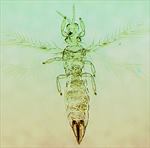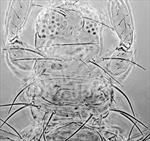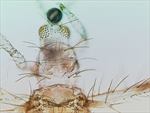
Female

Female colour variation within a reared population

Antenna

Head & pronotum

Head and pronotum

Head & thorax

Fore wing
Female macropterous. Body colour yellow with grey markings laterally on pronotum; metascutellum shaded, abdominal tergites II–IV shaded medially but yellow laterally; pronotal setae dark; antennal segments III–VIII grey; fore wings pale with 2 small dark transverse bands, clavus also dark. Antennae 8-segmented, III & IV each with long forked sense cone. Head wider than long, without sculpture between ocelli; 3 pairs of ocellar setae present, pair III very long and arising on anterior margins of ocellar triangle; postocular setae small, pair I close together behind hind ocelli. Pronotum with 6 pairs of very long setae. Metanotum with weak reticulate sculpture, campaniform sensilla absent, median setae arising at anterior margin. Meso- and metafurca with spinula. Fore wing first and second veins each with about 5–7 long setae; clavus with only 3 veinal setae, sub-terminal longer than terminal. Tergites with no sculpture medially, VIII without posteromarginal comb, X with no median longitudinal split. Sternites without discal setae, setae S1 on sternite VII arising in front of margin.
Male similar to female but smaller; sternites III–VIII with broadly transverse pore plate that is shorter medially than laterally.
This is an essentially Old World genus in which 14 species are currently recognised (ThripsWiki, 2018; Mound, 2011). S. sexmaculatus, S. hoodi and S. pallidus all come from North America, and differ from most of the Old World species in having a pair of discal setae near the posterior margin of the pronotum. Currently there is some doubt that these three are different species - they may be colour variants associated with differences in temperature during development. Certainly considerable colour variation occurs within samples of populations reared commercially in California for sale as biocontrol agents against leaf mites.
Predatory on leaf mites, and collected from many different plants, particularly bean crops and fruit trees.
This species has been identified for certain only from North America, and records from the Old World, including Australia, probably all refer to S. rhagebianus. It is produced commercially in California as a biocontrol agent against leaf-feeding mites (Mound, 2011).
THRIPIDAE - THRIPINAE
Scolothrips sexmaculatus (Pergande)
Thrips sexmaculatus Pergande, 1890: 539.
Mound LA (2011) Species recognition in the genus Scolothrips (Thysanoptera, Thripidae), predators of leaf-feeding mites. Zootaxa 2797: 45–53.